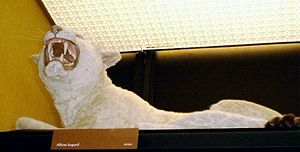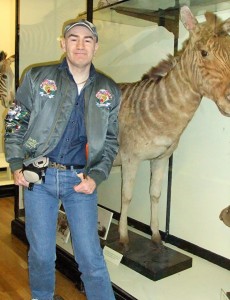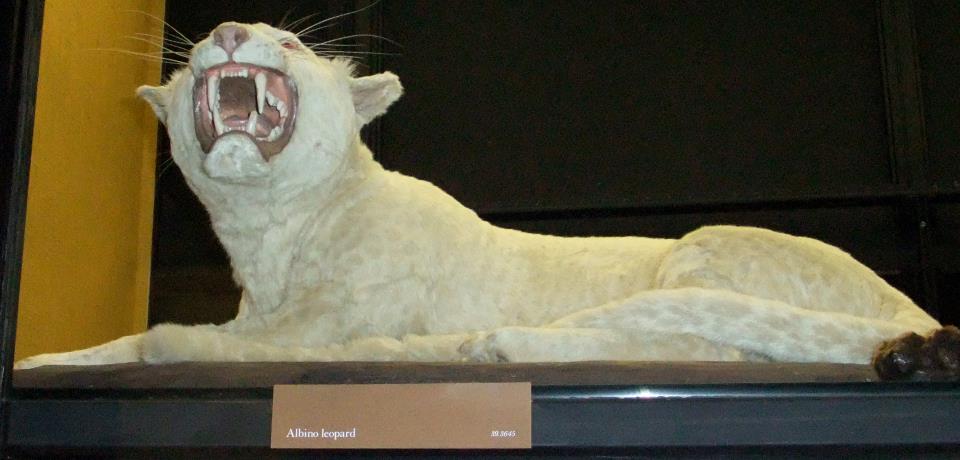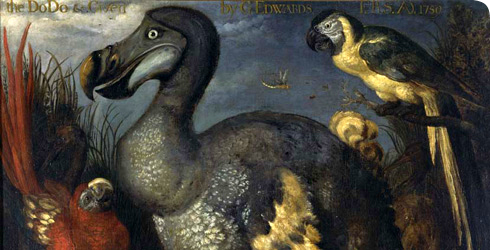
The image from Wikipedia.
December 12, 2011
The Walter Rothschild Zoological or Natural History Museum at Tring is located on Akeman Street, Tring, Herts, United Kingdom. It reportedly has in its collection a “White Panther,” which according to the following account at Wikipedia makes it sound like this specific one is a “White Cougar.”

The image from Wikipedia.
The Wikipedia one sentence description says: “There are reports that a white cougar is displayed at the Walter Rothschild Zoological Museum, Tring, England, being the same white cougar that London Zoo bought from the animal dealer Jamrach and which lived at London Zoo from May 1848 until January 1852.”
But is the story of this “White Panther” being a “White Cougar” so simple?

Karl Shuker at the Tring, December 9, 2011, pictured with a quagga.
On Friday, December 9th, Karl Shuker (author of the forthcoming The Encyclopaedia of New and Rediscovered Animals: From the Lost Ark to the New Zoo – and Beyond) decided to realize “a life-long ambition,” and, “as a birthday treat” to himself, “visited this fantastic museum.” He wished to determine whether the “White Panther” there was a “White Cougar.”
Karl shared, instead, “I can confirm that it is a white (albino) leopard.”

Karl Shuker photo.
I followed up with Karl, and asked him if there was any additional information on this leopard. Was it from Africa? Asia?
Since he did not have anything further, I decided to directly contact the museum.
I soon heard from the staff, Ms. Louise Tomsett, Archives, and Ms. Alice Adams, Interpretation and Learning Manager, who obtained the following data from their Mammal section registers. The information obtainable on the white felid is that it is a,
Leopard Panthera pardus
Asia
Albino
Skin
39.3645
BTW, the Tring is conducting significant research on dodos.

The iconic image of the dodo as painted by Roelandt Savery in 1626
The dodo became extinct within 90 years of its discovery by Europeans. Its extinction was a result of over-hunting, habitat loss and competition from introduced animals. The popular image of the flightless bird comes from paintings made at the time but today scientists think it probably looked somewhat different.
More on their dodo research, click here.
When in Maine, USA, visit another museum… the International Cryptozoology Museum. Thank you.

Thank you!
About Loren Coleman
Loren Coleman is one of the world’s leading cryptozoologists, some say “the” leading living cryptozoologist. Certainly, he is acknowledged as the current living American researcher and writer who has most popularized cryptozoology in the late 20th and early 21st centuries.
Starting his fieldwork and investigations in 1960, after traveling and trekking extensively in pursuit of cryptozoological mysteries, Coleman began writing to share his experiences in 1969. An honorary member of Ivan T. Sanderson’s Society for the Investigation of the Unexplained in the 1970s, Coleman has been bestowed with similar honorary memberships of the North Idaho College Cryptozoology Club in 1983, and in subsequent years, that of the British Columbia Scientific Cryptozoology Club, CryptoSafari International, and other international organizations. He was also a Life Member and Benefactor of the International Society of Cryptozoology (now-defunct).
Loren Coleman’s daily blog, as a member of the Cryptomundo Team, served as an ongoing avenue of communication for the ever-growing body of cryptozoo news from 2005 through 2013. He returned as an infrequent contributor beginning Halloween week of 2015.
Coleman is the founder in 2003, and current director of the International Cryptozoology Museum in Portland, Maine.
Filed under Alien Big Cats, Breaking News, Cryptomundo Exclusive, Cryptotourism, CryptoZoo News, Museums, Mystery Cats